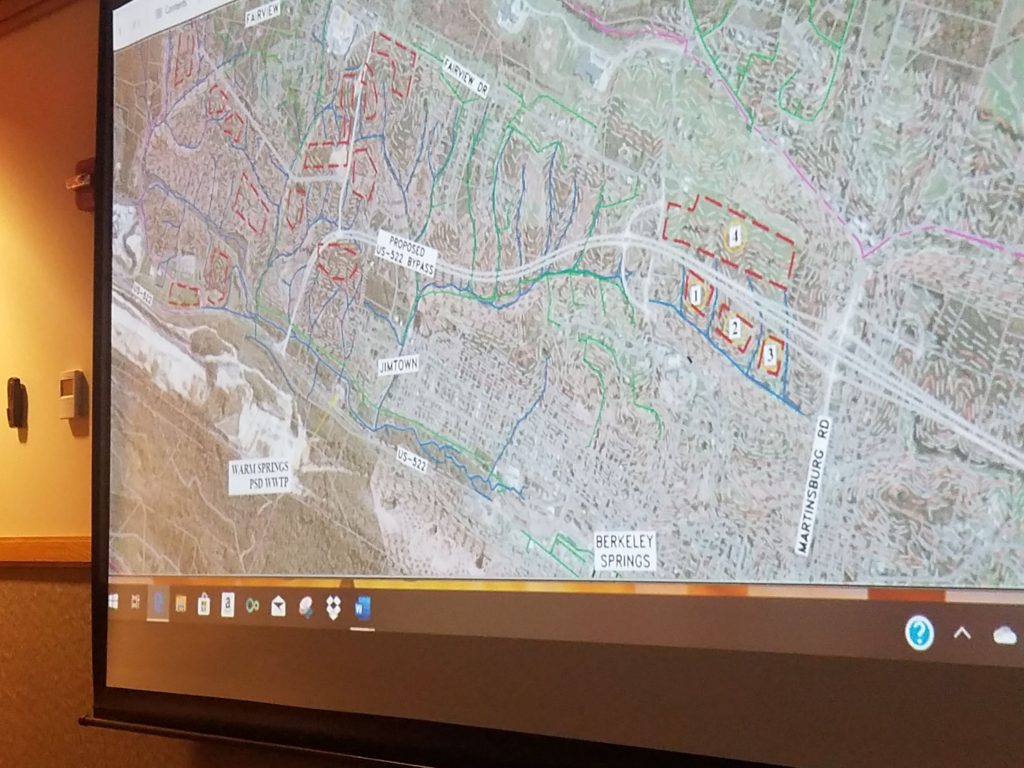Let’s call it the TIF (Tax Increment Financing) working group.
They met yesterday at the Morgan County Courthouse to discuss plans to develop land around the proposed bypass.
In the group were the Morgan County Commissioners – Joel Tuttle, Ken Reed and Sean Forney. The Morgan County Economic Development Authority – led by Daryl Cowles. Robert Milne, an engineer from The Thrasher Group in Bridgeport, West Virginia. And Joshua Jarrell, an attorney at Steptoe & Johnson in Bridgeport.
(Both Milne and Jarrell said they came up from Bridgeport as volunteers and weren’t billing the Commission, the EDA or anyone else for their time.)
In the audience were three citizens.
One of the citizens, John Webster, got into a discussion pre-meeting with Commissioner Ken Reed. Webster made the argument that TIFs are just corporate welfare.
Webster quoted a Baltimore Sun editorial arguing that a TIF “gives developers who secure tax increment financing an edge over competing developers who aren’t so politically well-connected. It also passes on unreasonable risk to the county government – and thus the taxpayers – by putting the government in the business of speculative development financing. In other words, TIF is bad public policy amounting to welfare for the wealthy.”
Webster said during this back and forth Reed told him – “you are allowed to lie to the public – as a First Amendment right – unless you are under oath.”
“Can I quote you on that?” Webster asked.
“Yes,” Reed said.
Milne had developed maps showing three sets of development pads – one set on the spur that goes to the hospital, one on the Rt. 9 interchange and one on Myers Road. Milne said that Thrasher picked the parcels “without looking at who owned the property.”
Cowles said that given that the state went to market on more than $700 million in road bonds this week, he expects bulldozers to start moving dirt for the bypass “within six months.”
Jarrell said while the state is spending millions of dollars on road projects in West Virginia, there is no new project like the new $70 million Berkeley Springs bypass and that would be a “draw for developers.”
But Jarrell also said that usually TIFs don’t take off unless the local government has “a bird in the hand, or at least a bird circling the hand.”
Cowles was asked whether he had a bird in hand or a bird circling the hand.
“We don’t,” Cowles said. “Except for the spur that goes to the hospital. We are in conversations with Valley Health about that.”
(Jeanne Mozier told Morgan County USA that she was told recently by Valley Health officials that there were no plans for further development in the area of the hospital.)
Cowles says that he could see long term care facilities and other medical businesses drawn to that area.
As for the Rt. 9 interchange, Sean Forney said he could see something like a Love’s Truck Stop, a Hampton Inn, a Taco Bell and a KFC going there. Neither Forney nor Tuttle said they thought a TIF was needed to draw that kind of development to the Rt. 9 Interchange.
The commissioners seemed to think that the only spot where the TIF would be needed to lure developers would be the parcels circled around Myers Road. That’s because there is no interchange there and Myers Road infrastructure would need to be built out.
Cowles seemed excited about the possibility of resurrecting the 18-mile four lane highway project that would go from the Hancock bridge to the Virginia line.
Cowles said the current traffic through Morgan County is about 15,000 cars a day. If the bypass bumps that up to 25,000 cars a day, that might breath new life into the Maryland to Virginia four lane bypass, he said.
Reed wondered aloud whether it would be possible for him, as a Commissioner, to develop one of the Myers Road parcels.
“There aren’t that many developers in Morgan County,” Reed said.

